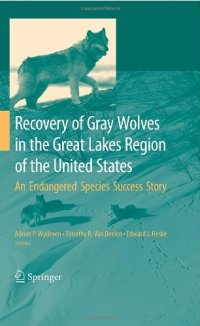
Ebook: Recovery of Gray Wolves in the Great Lakes Region of the United States: An Endangered Species Success Story
- Genre: History
- Tags: Nature Conservation, Environmental Management, Animal Ecology, Environmental Law/Policy/Ecojustice, Landscape Ecology, Community & Population Ecology
- Year: 2009
- Publisher: Springer-Verlag New York
- Edition: 1
- Language: English
- pdf
The western Great Lakes region of the United States is the only portion of the lower 48 states where wolves were never completely extirpated. This region contains the areas where many of the first modern concepts of wolf conservation and research were developed, and where many early proponents of wolf conservation such as Aldo Leopold, Sigurd Olson, and Durward Allen lived and worked. The Great Lakes region also is the first place in the U. S. where "endangered" wolf populations recovered. During this recovery, we learned much about wolf biology and ecology, endangered species management, carnivore conservation, landscape ecology, depredation management, and social aspects of wildlife conservation. "Recovery of Gray Wolves in the Great Lakes Region of the United States," traces wolf recovery from diverse perspectives ranging from ecology, management, and policy to the cultural, social, and historical significance of wolves.
Several years ago, as I visited with my friend Adrian Wydeven in his Park Falls, Wisconsin, office at the Department of Natural Resources Headquarters, I commented to him that he needed to write a book on his "Wolf Project" that at that time was just starting to show exciting results. Two of the wolves in this study wore radio collars that I provided as I really wanted to be a part of this project as a "civilian". Adrian laughed at the suggestion and said "Maybe...". Well, here is his book! But, as Adrian would, he shared authorship with many specialists who helped bring this project to a tremendously successful conclusion. The specialists who participated in this book are the most knowledgeable experts in their area. Adrian assembled a heck of a team and what they have to say about the part they each played makes for exciting reading! Adrian includes many pages of names and email adddresses of his team members and this book is only the first steppingstone if you really want to find out about the Wisconsin gray wolf re-introduction program. They are beautiful animals to have back in the ecosystem. Tell Adrian I sent you! (Greg T., Hayward, Wisconsin)